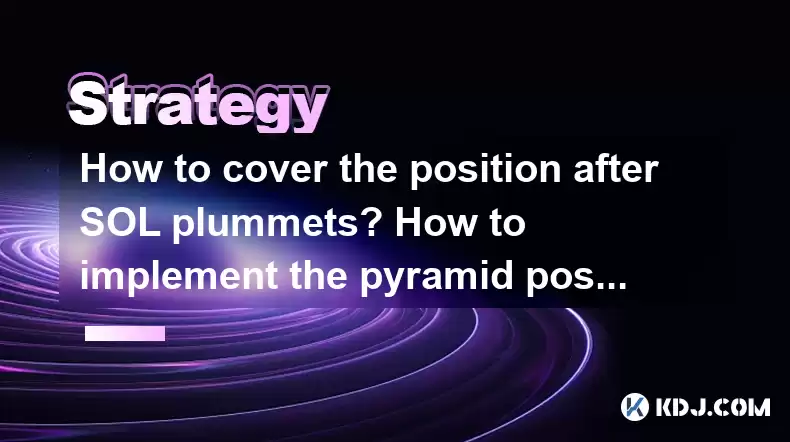-
 bitcoin
bitcoin $112715.707551 USD
-1.71% -
 ethereum
ethereum $4101.475385 USD
-3.01% -
 tether
tether $1.000644 USD
-0.02% -
 bnb
bnb $1207.619465 USD
-6.77% -
 xrp
xrp $2.501451 USD
-3.98% -
 solana
solana $202.947124 USD
-3.32% -
 usd-coin
usd-coin $1.000295 USD
0.04% -
 dogecoin
dogecoin $0.203884 USD
-4.47% -
 tron
tron $0.317154 USD
-1.72% -
 cardano
cardano $0.695009 USD
-4.43% -
 hyperliquid
hyperliquid $38.853961 USD
-8.23% -
 chainlink
chainlink $18.988674 USD
-4.64% -
 ethena-usde
ethena-usde $1.000233 USD
-0.03% -
 stellar
stellar $0.337050 USD
-3.63% -
 bitcoin-cash
bitcoin-cash $536.861728 USD
-1.28%
How to cover the position after SOL plummets? How to implement the pyramid position method?
When SOL plummets, use the pyramid position method: start small, add in tiers as the price rises, and manage risk by setting stop-losses and diversifying your portfolio.
Apr 29, 2025 at 04:22 am

When the price of Solana (SOL) plummets, investors often face the challenge of deciding how to cover their positions and potentially mitigate losses. One effective strategy to manage such situations is the pyramid position method. This article will guide you through the process of covering your position after a SOL price drop and implementing the pyramid position method to manage your investments.
Understanding the Pyramid Position Method
The pyramid position method is a strategy used by traders to build their positions in a tiered manner. Instead of investing all funds at once, investors add to their position in increments as the price moves in their favor. This method allows traders to manage risk and potentially increase their returns by averaging down their cost basis.
Assessing the SOL Price Drop
Before taking any action, it's crucial to assess the current market situation. When SOL plummets, you should analyze the reasons behind the drop, such as market sentiment, fundamental changes, or technical indicators. Understanding these factors will help you make informed decisions about whether to cover your position or hold onto it.
Covering Your Position After a SOL Price Drop
To cover your position after a SOL price drop, you need to decide whether to sell, hold, or buy more. Here are the steps to follow:
- Evaluate your risk tolerance: Determine how much risk you are willing to take. If the price drop has made you uncomfortable, it might be time to sell some or all of your position.
- Set stop-loss orders: If you decide to hold, setting a stop-loss order can help limit potential losses. For example, you might set a stop-loss at a certain percentage below the current price.
- Consider buying more: If you believe in the long-term potential of SOL and the price drop is a temporary dip, you might decide to buy more to lower your average cost per unit.
Implementing the Pyramid Position Method with SOL
To implement the pyramid position method with SOL, follow these steps:
- Start with an initial position: Begin by investing a small portion of your total intended investment. For example, if you plan to invest $10,000 in SOL, start with $2,000.
- Add to your position in tiers: As the price of SOL moves in your favor, add to your position in smaller increments. For instance, after the price increases by 5%, you might add another $1,000. After another 5% increase, add another $1,000, and so on.
- Monitor the market closely: Keep a close eye on the market to determine when to add to your position. If the price starts to decline, you may want to pause adding to your position until the trend reverses.
- Use technical analysis: Utilize technical indicators such as moving averages, RSI, and support/resistance levels to help you decide when to add to your position.
Example of Pyramid Position Method with SOL
Let's walk through an example of how to use the pyramid position method with SOL:
- Initial Investment: You start by investing $2,000 in SOL at a price of $100 per SOL, buying 20 SOL.
- First Tier: The price of SOL increases to $105. You add another $1,000, buying approximately 9.52 SOL (at $105 per SOL), bringing your total to 29.52 SOL.
- Second Tier: The price rises to $110. You add another $1,000, buying approximately 9.09 SOL (at $110 per SOL), bringing your total to 38.61 SOL.
- Third Tier: The price reaches $115. You add another $1,000, buying approximately 8.70 SOL (at $115 per SOL), bringing your total to 47.31 SOL.
By using the pyramid position method, you've gradually increased your position as the price moved in your favor, potentially maximizing your returns while managing risk.
Managing Risk with the Pyramid Position Method
While the pyramid position method can be effective, it's important to manage risk carefully. Here are some tips to help you do so:
- Diversify your portfolio: Don't put all your funds into one asset like SOL. Diversifying across different cryptocurrencies can help mitigate risk.
- Set clear exit points: Determine at what price levels you will sell your SOL to lock in profits or cut losses.
- Stay informed: Keep up with news and developments that could impact the price of SOL. This will help you make more informed decisions about when to add to your position or exit.
Adjusting Your Strategy Based on Market Conditions
Market conditions can change rapidly, and it's important to adjust your strategy accordingly. If the price of SOL starts to decline after you've built up your position using the pyramid method, you may need to reassess your approach:
- Re-evaluate your position: If the price drop is significant, consider whether it's time to sell some of your SOL to lock in profits or cut losses.
- Pause adding to your position: If the price is trending downward, it may be wise to pause adding to your position until the trend reverses.
- Consider other strategies: Depending on the market conditions, other strategies such as dollar-cost averaging or hedging might be more appropriate.
Frequently Asked Questions
Q: Can the pyramid position method be used with other cryptocurrencies besides SOL?A: Yes, the pyramid position method can be applied to any cryptocurrency. The key is to start with a small initial investment and add to your position in tiers as the price moves in your favor.
Q: What are the risks associated with the pyramid position method?A: The main risks include the potential for the price to reverse after you've added to your position, leading to losses. Additionally, if you're not careful, you might over-leverage your position, increasing your risk exposure.
Q: How often should I add to my position using the pyramid method?A: The frequency of adding to your position depends on your risk tolerance and the market conditions. Some traders add to their position after a certain percentage increase, while others might do so based on specific technical indicators.
Q: Is the pyramid position method suitable for beginners?A: The pyramid position method can be suitable for beginners, but it requires a good understanding of market trends and risk management. Beginners should start with small investments and gradually learn to apply the method as they gain more experience.
Disclaimer:info@kdj.com
The information provided is not trading advice. kdj.com does not assume any responsibility for any investments made based on the information provided in this article. Cryptocurrencies are highly volatile and it is highly recommended that you invest with caution after thorough research!
If you believe that the content used on this website infringes your copyright, please contact us immediately (info@kdj.com) and we will delete it promptly.
- PayPal, PYUSD, and Stablecoins: Riding the Wave of Digital Finance
- 2025-10-16 04:50:01
- Milk Mocha's $HUGS Token: Why the Whitelist & Presale 2025 are Exploding
- 2025-10-16 04:30:01
- Microsoft, Bitcoin, and GitHub: A Balancing Act in the Digital Age
- 2025-10-16 04:30:01
- Navigating the Crypto Chaos: Bitcoin Crash, Maturing Meme Coins, and Market Momentum
- 2025-10-16 04:30:01
- Sui Platform's Typus Finance Hit by Oracle Exploit: A Deep Dive
- 2025-10-16 05:10:01
- Solana's On-Chain Growth: Grayscale's Bets and the $260 Target
- 2025-10-16 04:40:01
Related knowledge

Practical parameter settings for a Bitcoin multi-timeframe moving average system
Sep 18,2025 at 10:54pm
Optimizing Timeframe Combinations for Bitcoin Trading1. Selecting appropriate timeframes is crucial when building a multi-timeframe moving average sys...

How can I filter out false breakouts in Dogecoin high-frequency trading?
Sep 22,2025 at 01:00am
Understanding False Breakouts in Dogecoin Trading1. A false breakout occurs when Dogecoin's price appears to move beyond a defined support or resistan...

Techniques for identifying tops and bottoms in the Bitcoin on-chain NVT model
Sep 20,2025 at 07:54pm
Understanding the NVT Model in Bitcoin Analysis1. The Network Value to Transactions (NVT) ratio is often described as the 'P/E ratio' of the cryptocur...

What does the surge in open interest in Bitcoincoin futures mean?
Sep 20,2025 at 11:18pm
Understanding the Surge in Dogecoin Futures Open Interest1. A surge in open interest within Dogecoin futures indicates a growing number of active cont...

How can I use the Ethereum USDT premium to gauge market sentiment?
Sep 18,2025 at 11:55pm
Understanding the Ethereum USDT Premium1. The Ethereum USDT premium refers to the price difference between USDT (Tether) traded on Ethereum-based plat...

What should I do if Ethereum staking yields decline?
Sep 20,2025 at 06:18am
Understanding the Causes Behind Declining Ethereum Staking Yields1. The Ethereum network transitioned to a proof-of-stake consensus mechanism with the...

Practical parameter settings for a Bitcoin multi-timeframe moving average system
Sep 18,2025 at 10:54pm
Optimizing Timeframe Combinations for Bitcoin Trading1. Selecting appropriate timeframes is crucial when building a multi-timeframe moving average sys...

How can I filter out false breakouts in Dogecoin high-frequency trading?
Sep 22,2025 at 01:00am
Understanding False Breakouts in Dogecoin Trading1. A false breakout occurs when Dogecoin's price appears to move beyond a defined support or resistan...

Techniques for identifying tops and bottoms in the Bitcoin on-chain NVT model
Sep 20,2025 at 07:54pm
Understanding the NVT Model in Bitcoin Analysis1. The Network Value to Transactions (NVT) ratio is often described as the 'P/E ratio' of the cryptocur...

What does the surge in open interest in Bitcoincoin futures mean?
Sep 20,2025 at 11:18pm
Understanding the Surge in Dogecoin Futures Open Interest1. A surge in open interest within Dogecoin futures indicates a growing number of active cont...

How can I use the Ethereum USDT premium to gauge market sentiment?
Sep 18,2025 at 11:55pm
Understanding the Ethereum USDT Premium1. The Ethereum USDT premium refers to the price difference between USDT (Tether) traded on Ethereum-based plat...

What should I do if Ethereum staking yields decline?
Sep 20,2025 at 06:18am
Understanding the Causes Behind Declining Ethereum Staking Yields1. The Ethereum network transitioned to a proof-of-stake consensus mechanism with the...
See all articles










































































